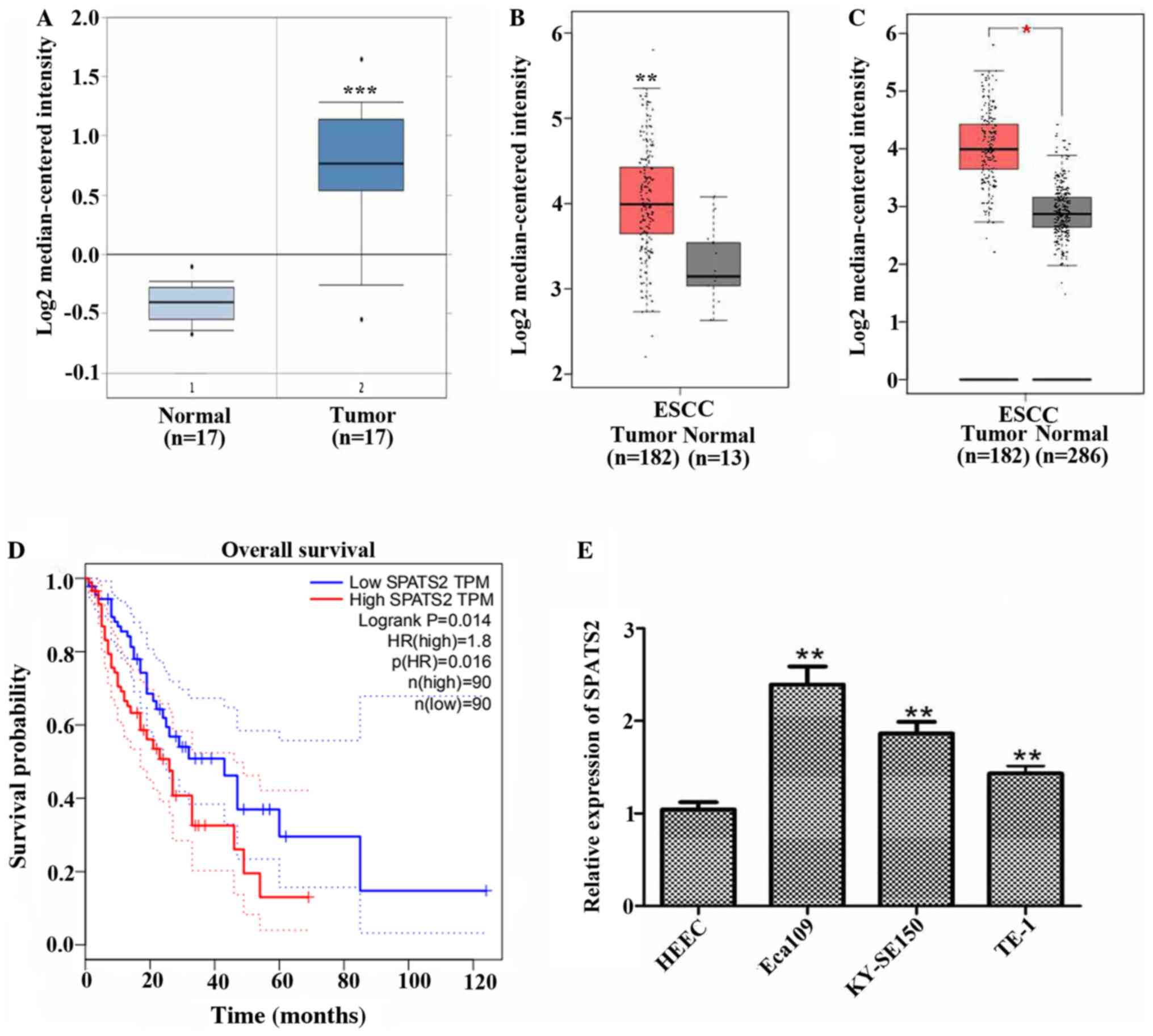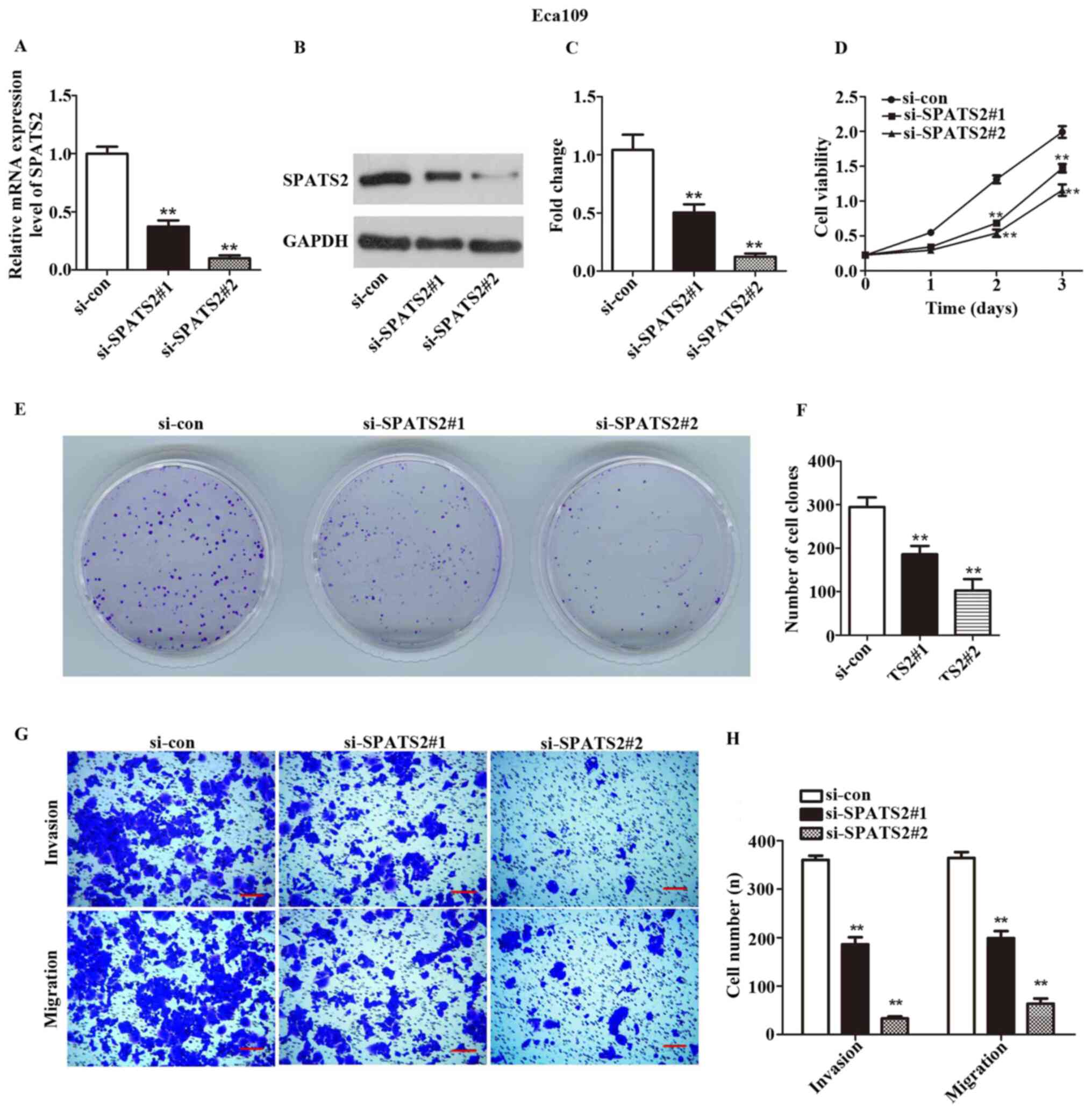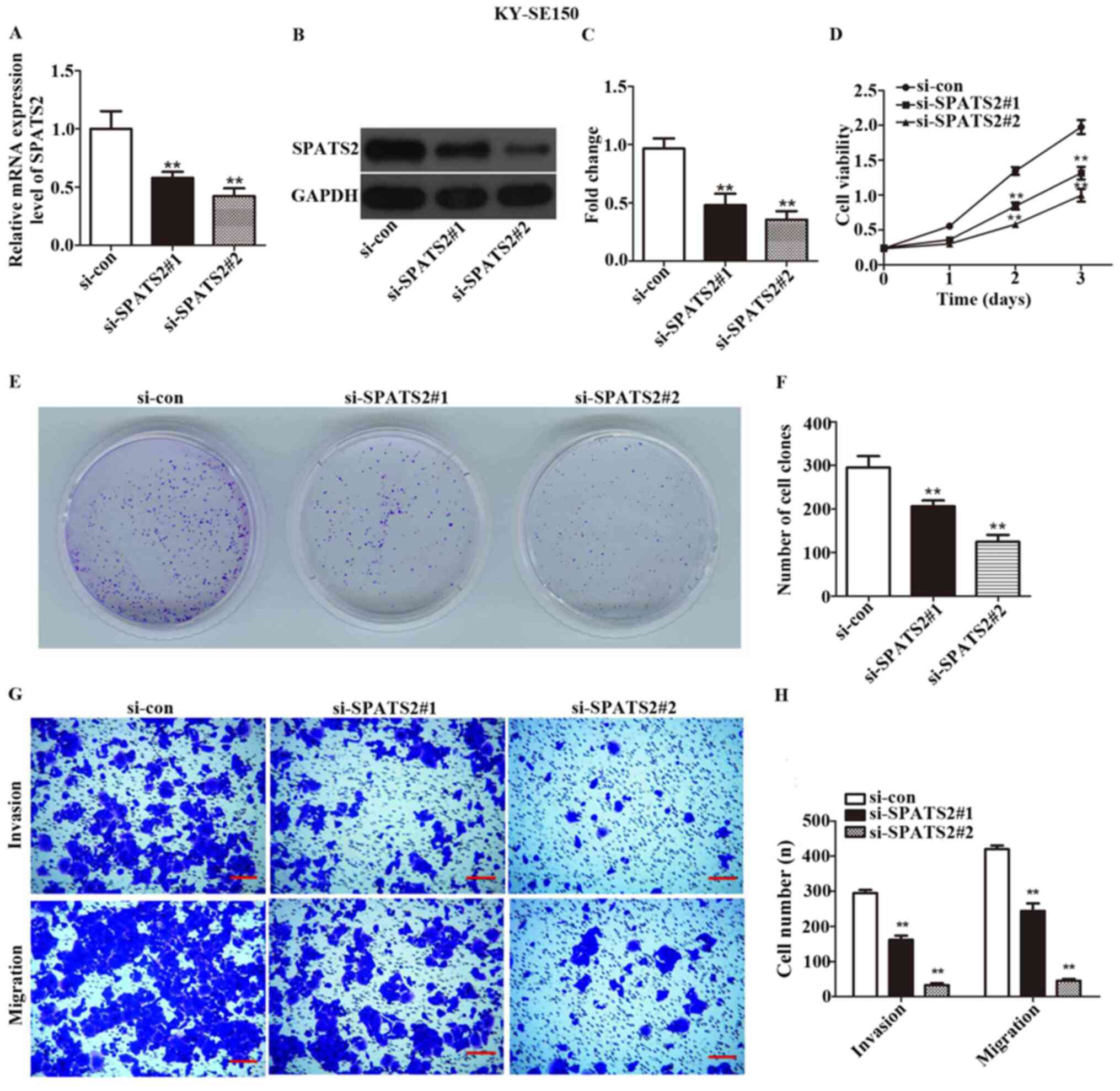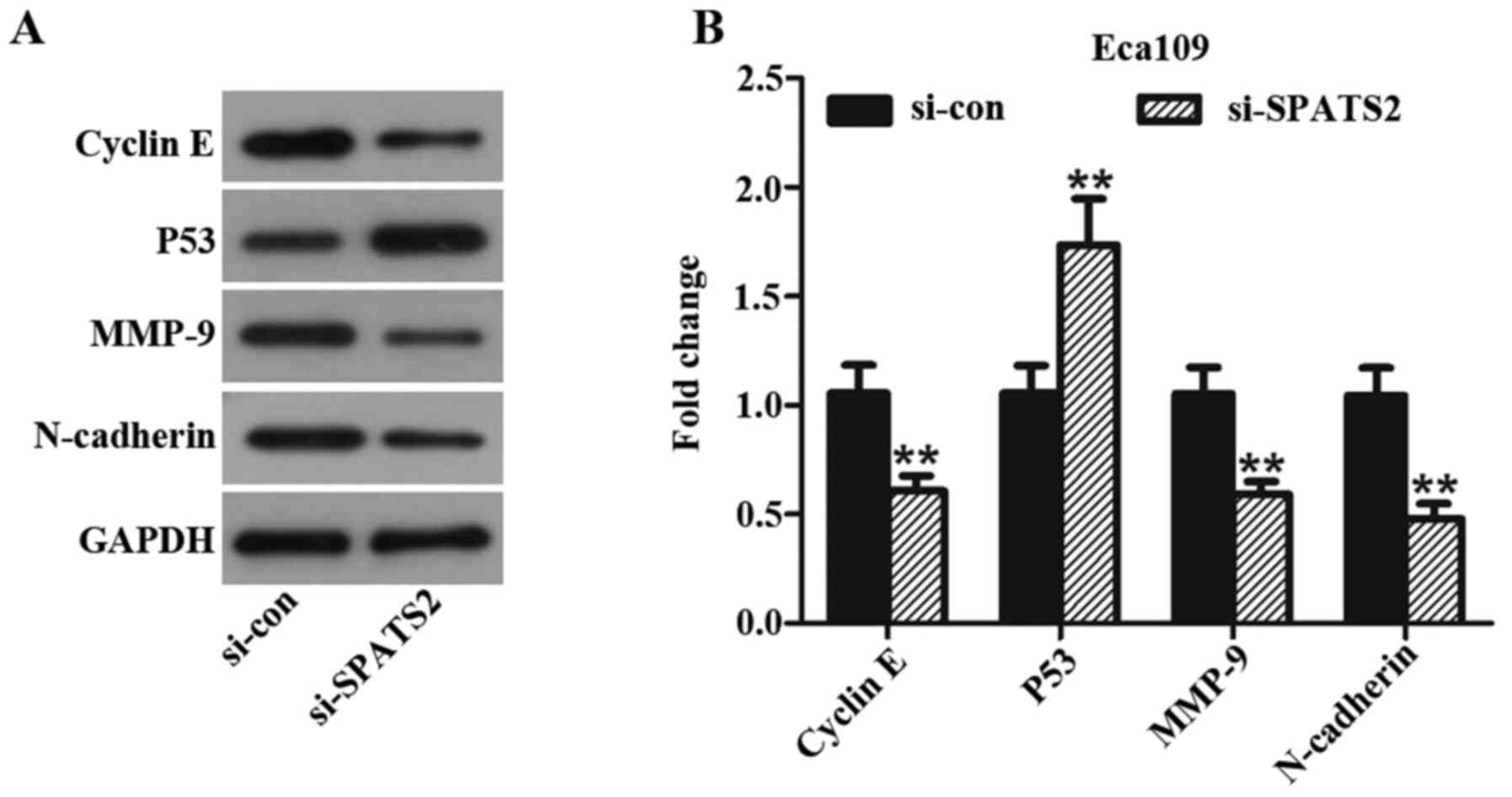|
1
|
Hu JM, Liu K, Liu JH, Jiang XL, Wang XL,
Chen YZ, Li SG, Zou H, Pang LJ, Liu CX, et al: CD163 as a marker of
M2 macrophage, contribute to predict aggressiveness and prognosis
of Kazakh esophageal squamous cell carcinoma. Oncotarget.
8:21526–21538. 2017.PubMed/NCBI View Article : Google Scholar
|
|
2
|
Sakai NS, Samia-Aly E, Barbera M and
Fitzgerald RC: A review of the current understanding and clinical
utility of miRNAs in esophageal cancer. Semin Cancer Biol.
23:512–521. 2013.PubMed/NCBI View Article : Google Scholar
|
|
3
|
Torre LA, Bray F, Siegel RL, Ferlay J,
Lortet-Tieulent J and Jemal A: Global cancer statistics, 2012. CA
Cancer J Clin. 65:87–108. 2015.PubMed/NCBI View Article : Google Scholar
|
|
4
|
Murphy G, McCormack V, Abedi-Ardekani B,
Arnold M, Camargo MC, Dar NA, Dawsey SM, Etemadi A, Fitzgerald RC,
Fleischer DE, et al: International cancer seminars: A focus on
esophageal squamous cell carcinoma. Ann Oncol. 28:2086–2093.
2017.PubMed/NCBI View Article : Google Scholar
|
|
5
|
Gao S, Li S, Duan X, Gu Z, Ma Z, Yuan X,
Feng X and Wang H: Inhibition of glycogen synthase kinase 3 beta
(GSK3beta) suppresses the progression of esophageal squamous cell
carcinoma by modifying STAT3 activity. Mol Carcinog. 56:2301–2316.
2017.PubMed/NCBI View
Article : Google Scholar
|
|
6
|
Wang C, Wang J, Chen Z, Gao Y and He J:
Immunohistochemical prognostic markers of esophageal squamous cell
carcinoma: A systematic review. Chin J Cancer.
36(65)2017.PubMed/NCBI View Article : Google Scholar
|
|
7
|
Ekman S, Dreilich M, Lennartsson J,
Wallner B, Brattstrom D, Sundbom M and Bergqvist M: Esophageal
cancer: Current and emerging therapy modalities. Expert Rev
Anticancer Ther. 8:1433–1448. 2008.PubMed/NCBI View Article : Google Scholar
|
|
8
|
Senoo M, Hoshino S, Mochida N, Matsumura Y
and Habu S: Identification of a novel protein p59(scr), which is
expressed at specific stages of mouse spermatogenesis. Biochem
Biophys Res Commun. 292:992–998. 2002.PubMed/NCBI View Article : Google Scholar
|
|
9
|
Damas ND, Marcatti M, Come C, Christensen
LL, Nielsen MM, Baumgartner R, Gylling HM, Maglieri G, Rundsten CF,
Seemann SE, et al: SNHG5 promotes colorectal cancer cell survival
by counteracting STAU1-mediated mRNA destabilization. Nat Commun.
7(13875)2016.PubMed/NCBI View Article : Google Scholar
|
|
10
|
Ngollo M, Lebert A, Daures M, Judes G,
Rifai K, Dubois L, Kemeny JL, Penault-Llorca F, Bignon YJ, Guy L
and Bernard-Gallon D: Global analysis of H3K27me3 as an epigenetic
marker in prostate cancer progression. BMC Cancer.
17(261)2017.PubMed/NCBI View Article : Google Scholar
|
|
11
|
Takamochi K, Ohmiya H, Itoh M, Mogushi K,
Saito T, Hara K, Mitani K, Kogo Y, Yamanaka Y, Kawai J, et al:
Novel biomarkers that assist in accurate discrimination of squamous
cell carcinoma from adenocarcinoma of the lung. BMC Cancer.
16(760)2016.PubMed/NCBI View Article : Google Scholar
|
|
12
|
Zhu CH, Kim J, Shay JW and Wright WE:
SGNP: An essential Stress Granule/Nucleolar Protein potentially
involved in 5.8s rRNA processing/transport. PLoS One.
3(e3716)2008.PubMed/NCBI View Article : Google Scholar
|
|
13
|
Donati G, Montanaro L and Derenzini M:
Ribosome biogenesis and control of cell proliferation: p53 is not
alone. Cancer Res. 72:1602–1607. 2012.PubMed/NCBI View Article : Google Scholar
|
|
14
|
Min P, Li W, Zeng D, Ma Y, Xu D, Zheng W,
Tang F, Chen J, Shi J, Hu H, et al: A single nucleotide variant in
microRNA-1269a promotes the occurrence and process of
hepatocellular carcinoma by targeting to oncogenes SPATS2L and
LRP6. Bull Cancer. 104:311–320. 2017.PubMed/NCBI View Article : Google Scholar
|
|
15
|
Livak KJ and Schmittgen TD: Analysis of
relative gene expression data using real-time quantitative PCR and
the 2(-Delta Delta C(T)) method. Methods. 25:402–8. 2001.PubMed/NCBI View Article : Google Scholar
|
|
16
|
Baba Y, Saeki H, Nakashima Y, Oki E,
Shigaki H, Yoshida N, Watanabe M, Maehara Y and Baba H: Review of
chemotherapeutic approaches for operable and inoperable esophageal
squamous cell carcinoma. Dis Esophagus. 30:1–7. 2017.PubMed/NCBI View Article : Google Scholar
|
|
17
|
Seki K, Koshi R, Sugano N, Masutani S,
Yoshinuma N and Ito K: Microarray analysis of bisphenol A-induced
changes in gene expression in human oral epithelial cells. Acta
Biochim Biophys Sin (Shanghai). 39:879–884. 2007.PubMed/NCBI View Article : Google Scholar
|
|
18
|
Cicenas J, Tamosaitis L, Kvederaviciute K,
Tarvydas R, Staniute G, Kalyan K, Meskinyte-Kausiliene E,
Stankevicius V and Valius M: KRAS, NRAS and BRAF mutations in
colorectal cancer and melanoma. Med Oncol. 34(26)2017.PubMed/NCBI View Article : Google Scholar
|
|
19
|
Melo M, Gaspar da Rocha A, Batista R,
Vinagre J, Martins MJ, Costa G, Ribeiro C, Carrilho F, Leite V,
Lobo C, et al: TERT, BRAF, and NRAS in primary thyroid cancer and
metastatic disease. J Clin Endocrinol Metab. 102:1898–1907.
2017.PubMed/NCBI View Article : Google Scholar
|
|
20
|
Giannou AD, Marazioti A, Kanellakis NI,
Giopanou I, Lilis I, Zazara DE, Ntaliarda G, Kati D, Armenis V,
Giotopoulou GA, et al: NRAS destines tumor cells to the lungs. EMBO
Mol Med. 9:672–686. 2017.PubMed/NCBI View Article : Google Scholar
|
|
21
|
Li Y, Shan Z, Liu C, Yang D, Wu J, Men C
and Xu Y: MicroRNA-294 promotes cellular proliferation and motility
through the PI3K/AKT and JAK/STAT pathways by Upregulation of NRAS
in bladder cancer. Biochemistry (Mosc). 82:474–482. 2017.PubMed/NCBI View Article : Google Scholar
|
|
22
|
De Amicis F, Perri A, Vizza D, Russo A,
Panno ML, Bonofiglio D, Giordano C, Mauro L, Aquila S, Tramontano D
and Ando S: Epigallocatechin gallate inhibits growth and
epithelial-to-mesenchymal transition in human thyroid carcinoma
cell lines. J Cell Physiol. 228:2054–2062. 2013.PubMed/NCBI View Article : Google Scholar
|
|
23
|
Bellini MF, Cadamuro AC, Succi M, Proenca
MA and Silva AE: Alterations of the TP53 gene in gastric and
esophageal carcinogenesis. J Biomed Biotechnol.
2012(891961)2012.PubMed/NCBI View Article : Google Scholar
|
|
24
|
Zhang Y, Zhu C, Sun B, Lv J, Liu Z, Liu S
and Li H: Integrated high throughput analysis identifies GSK3 as a
crucial determinant of p53-mediated apoptosis in lung cancer cells.
Cell Physiol Biochem. 42:1177–1191. 2017.PubMed/NCBI View Article : Google Scholar
|
|
25
|
Dai L, Liu Y, Liu J, Wen X, Xu Z, Wang Z,
Sun H, Tang S, Maguire AR, Quan J, et al: A novel
cyclinE/cyclinA-CDK inhibitor targets p27(Kip1) degradation, cell
cycle progression and cell survival: Implications in cancer
therapy. Cancer Lett. 333:103–112. 2013.PubMed/NCBI View Article : Google Scholar
|
|
26
|
Huang L, Ren F, Tang R, Feng Z and Chen G:
Prognostic value of expression of Cyclin E in gastrointestinal
cancer: A systematic review and meta-analysis. Technol Cancer Res
Treat. 15:12–19. 2016.PubMed/NCBI View Article : Google Scholar
|
|
27
|
Thaker PH, Han LY, Kamat AA, Arevalo JM,
Takahashi R, Lu C, Jennings NB, Armaiz-Pena G, Bankson JA, Ravoori
M, et al: Chronic stress promotes tumor growth and angiogenesis in
a mouse model of ovarian carcinoma. Nat Med. 12:939–944.
2006.PubMed/NCBI View
Article : Google Scholar
|
|
28
|
Grunwald B, Vandooren J, Locatelli E,
Fiten P, Opdenakker G, Proost P, Kruger A, Lellouche JP, Israel LL,
Shenkman L and Comes Franchini M: Matrix metalloproteinase-9
(MMP-9) as an activator of nanosystems for targeted drug delivery
in pancreatic cancer. J Control Release. 239:39–48. 2016.PubMed/NCBI View Article : Google Scholar
|
|
29
|
Bai X, Li YY, Zhang HY, Wang F, He HL, Yao
JC, Liu L and Li SS: Role of matrix metalloproteinase-9 in
transforming growth factor-β1-induced epithelial-mesenchymal
transition in esophageal squamous cell carcinoma. Onco Targets
Ther. 10:2837–2847. 2017.PubMed/NCBI View Article : Google Scholar
|
|
30
|
Derycke LD and Bracke ME: N-cadherin in
the spotlight of cell-cell adhesion, differentiation,
embryogenesis, invasion and signalling. Int J Dev Biol. 48:463–476.
2004.PubMed/NCBI View Article : Google Scholar
|
|
31
|
Blaschuk OW: N-cadherin antagonists as
oncology therapeutics. Philos Trans R Soc Lond B Biol Sci.
370(20140039)2015.PubMed/NCBI View Article : Google Scholar
|


















